-
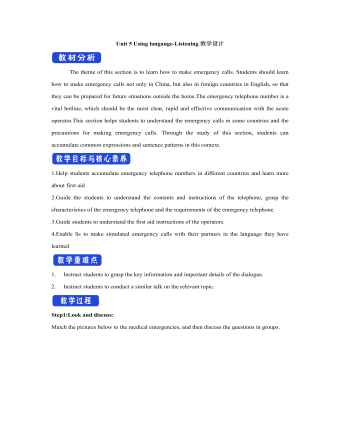
新人教版高中英语选修2Unit 5 Using langauge-Listening教学设计
The theme of this section is to learn how to make emergency calls. Students should learn how to make emergency calls not only in China, but also in foreign countries in English, so that they can be prepared for future situations outside the home.The emergency telephone number is a vital hotline, which should be the most clear, rapid and effective communication with the acute operator.This section helps students to understand the emergency calls in some countries and the precautions for making emergency calls. Through the study of this section, students can accumulate common expressions and sentence patterns in this context. 1.Help students accumulate emergency telephone numbers in different countries and learn more about first aid2.Guide the students to understand the contents and instructions of the telephone, grasp the characteristics of the emergency telephone and the requirements of the emergency telephone.3.Guide students to understand the first aid instructions of the operators.4.Enable Ss to make simulated emergency calls with their partners in the language they have learned1. Instruct students to grasp the key information and important details of the dialogue.2. Instruct students to conduct a similar talk on the relevant topic.Step1:Look and discuss:Match the pictures below to the medical emergencies, and then discuss the questions in groups.
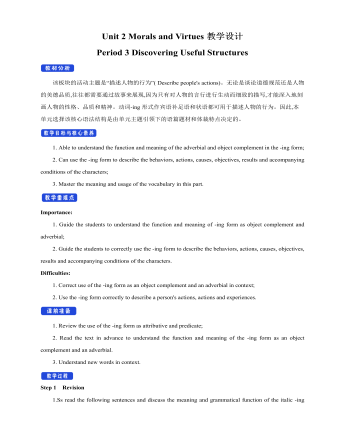
新人教版高中英语必修3Unit 2 Morals and Virtues教学设计三
The joke set her crying.这个玩笑使她哭起来。Step 5 ReadingActivity 31. Students read the small text in activity 3. The teacher provides several small questions to check whether students understand the content of the text and the ideographic function of the -ing form in the text.*Where are those people?*Why did Dr Bethune come to China?*How did he help the Chinese people during the war?*What did Chairman Mao Zedong say about him?2. Ss try to rewrite some sentences using the -ing form. Then check the answers. When checking the answers, the teacher can ask different students to read the rewritten sentences and give comments.Answers:1. he became very interested in medicine, deciding to become a doctor.2. …after hearing that many people were dying in the war.3. Helping to organise hospitals, he taught doctors and nurses, and showed people how to give first aid./ He helped to organise hospitals, teaching doctors and nurses, and showing people how to give first aid.4. …praising Dr Bethune as a hero to be remembered in China.Step 6 PracticeActivity 4Students complete grammar activities 2 and 3 on page 69 of the workbook.Step 6 Homework1. Understand and master the functions and usage of the -ing form;2. Finish the other exercises in Using structures.1、通过本节内容学习,学生是否理解和掌握动词-ing形式作宾语补足语语和状语语的功能和意义;2、通过本节内容学习,学生能否正确使用动词-ing形式描述人物的行为、动作及其经历;3、通过本节内容学习,学生能否独立完成练习册和导学案中的相关练习。
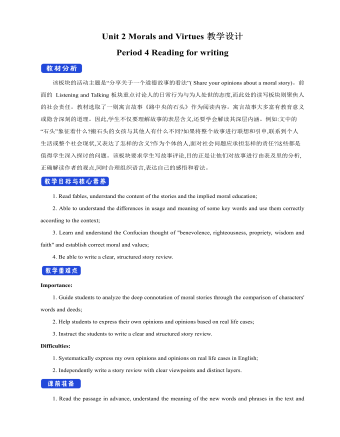
新人教版高中英语必修3Unit 2 Morals and Virtues教学设计四
3.Teachers ask different groups to report the answers to the questions and ask them to try different sentence patterns.The teacher added some sentence patterns for students to refer to when writing.Step 4 Writing taskActivity 51.Write the first draft.Students first review the evaluation criteria in activity 5, and then independently complete the draft according to the outline of activity 4, the answers to the questions listed in the group discussion and report, and the reference sentence pattern.2.Change partners.The teacher guides the students to evaluate their partner's composition according to the checklist of activity 5 and proposes Suggestions for modification.3.Finalize the draft.Based on the peer evaluation, students revise their own compositions and determine the final draft.Finally, through group recommendation, the teacher selects excellent compositions for projection display or reading aloud in class, and gives comments and Suggestions.Step 5 Showing writingActivity 5T call some Ss to share their writing.Step 6 Homework1. Read the passage in this section to better understand the passage.2. Carefully understand the hierarchical structure of the article, and deeply understand the plot of the story according to the causes, process and results;3. Independently complete the relevant exercises in the guide plan.1、通过本节内容学习,学生是否理解和掌握阅读文本中的新词汇的意义与用法;2、通过本节内容学习,学生能否通过人物言行的对比分析道德故事的深层内涵;3、通过本节内容学习,学生能否根据故事的起因、经过和结果来深入理解故事的情节,从而了解文章的层次结构;4、结合现实生活案例发表自己的见解和看法,写一篇观点明确、层次分明的故事评论。
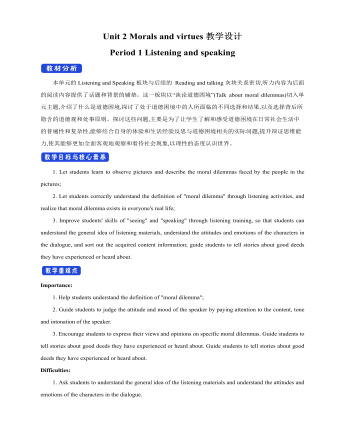
新人教版高中英语必修3Unit 2 Morals and virtues教学设计一
(2) students are divided into groups according to the requirements of activity 3. Each student shares a story of personal experience or hearing-witnessing kindness, and then selects the most touching story in the group and shares it with the whole class. Before the students share the story, the teacher can instruct them to use the words and sentence patterns in the box to express. For example, the words in the box can be classified:Time order: first of all, then, after that, later, finally logical relationship :so, however, although, butTeachers can also appropriately add some transitional language to enrich students' expression:Afterwards, afterwards, at last, in the end, eventuallySpatial order: next to, far from, on the left, in front ofOtherwise, nevertheless, as a result, therefore, furthermore, in addition, as well asSummary: in a word, in short, on the whole, to sum up, in briefStep 8 Homework1. Understand the definition of "moral dilemma" and establish a correct moral view;2. Accumulate vocabulary about attitudes and emotions in listening texts and use them to express your own views;3. Complete relevant exercises in the guide plan.1、通过本节内容学习,学生能否理解理解“道德困境”的定义;2、通过本节内容学习,学生能否通过说话人所表达的内容、说话的语气、语调等来判断其态度和情绪;3、通过本节内容学习,学生能否针对具体的道德困境发表自己的看法和见解,能否掌握听力理训练中的听力策略。
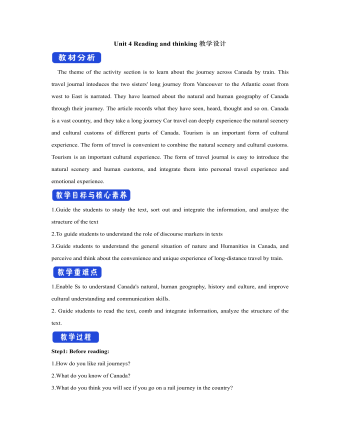
新人教版高中英语选修2Unit 4 Reading and thinking教学设计
【词汇精讲】highlight n.最好或最精彩的部分 vt.突出;强调;使醒目One of the highlights of the trip was seeing the Taj Mahal.这次旅行的亮点之一是参观泰姬陵。Your resume should highlight your skills and achievements.你的简历应该突出你的技能和成就。The report highlights the major problems facing society today.报告强调了当今社会所面临的主要问题。I’ve highlighted the important passages in yellow.我用黄色标出了重要段落。7.Edmonton is freezing cold in winter,with daily temperatures averaging -10 ℃.埃德蒙顿冬季寒冷,日平均气温为-10°C。【词汇精讲】freezing adj.极冷的;冰冻的Leave a basin of water outside in freezing weather.在冰冻的天气里,放一盆水在室外。It’s freezing cold outside so wear a warm coat.外面超冷的,所以穿一个暖和一点的外套吧。8.It was not until 9:30 a.m.that they finally reached the capital of Ontario,Toronto.直到上午9时30分,他们才终于到达多伦多的首府安大略省。【句式剖析】本句是一个强调句,强调的是句子的时间状语until 9:30。含有not...until...的句子的强调句为It is not until...that...,that后面的句子要用肯定形式。It was not until then that I suddenly realized nobody was happier than I was.直到那时我才突然意识到没有人比我更幸福了。
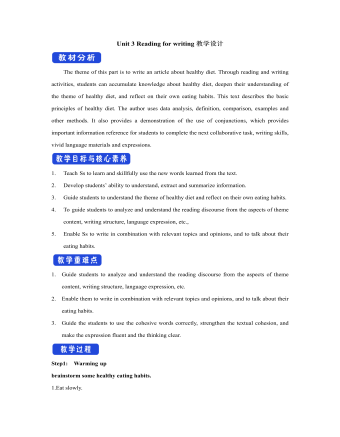
新人教版高中英语选修2Unit 3 Reading for writing教学设计
The theme of this part is to write an article about healthy diet. Through reading and writing activities, students can accumulate knowledge about healthy diet, deepen their understanding of the theme of healthy diet, and reflect on their own eating habits. This text describes the basic principles of healthy diet. The author uses data analysis, definition, comparison, examples and other methods. It also provides a demonstration of the use of conjunctions, which provides important information reference for students to complete the next collaborative task, writing skills, vivid language materials and expressions.1. Teach Ss to learn and skillfully use the new words learned from the text.2. Develop students’ ability to understand, extract and summarize information.3. Guide students to understand the theme of healthy diet and reflect on their own eating habits.4. To guide students to analyze and understand the reading discourse from the aspects of theme content, writing structure, language expression, etc., 5. Enable Ss to write in combination with relevant topics and opinions, and to talk about their eating habits.1. Guide students to analyze and understand the reading discourse from the aspects of theme content, writing structure, language expression, etc.2. Enable them to write in combination with relevant topics and opinions, and to talk about their eating habits.3. Guide the students to use the cohesive words correctly, strengthen the textual cohesion, and make the expression fluent and the thinking clear.Step1: Warming upbrainstorm some healthy eating habits.1.Eat slowly.2.Don’t eat too much fat or sugar.3.Eat healthy food.4.Have a balanced diet.Step2: Read the passage and then sum up the main idea of each paragraph.
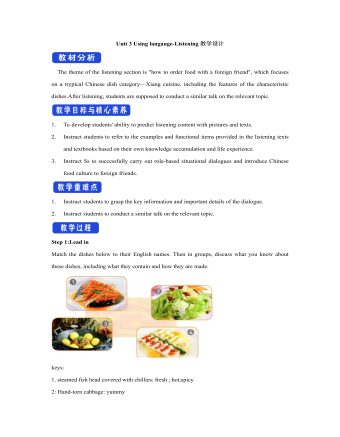
新人教版高中英语选修2Unit 3 Using langauge-Listening教学设计
1. How is Hunan cuisine somewhat different from Sichuan cuisine?The heat in Sichuan cuisine comes from chilies and Sichuan peppercorns. Human cuisine is often hotter and the heat comes from just chilies.2.What are the reasons why Hunan people like spicy food?Because they are a bold people. But many Chinese people think that hot food helps them overcome the effects of rainy or wet weather.3.Why do so many people love steamed fish head covered with chilies?People love it because the meat is quite tender and there are very few small bones.4.Why does Tingting recommend bridge tofu instead of dry pot duck with golden buns?Because bridge tofu has a lighter taste.5 .Why is red braised pork the most famous dish?Because Chairman Mao was from Hunan, and this was his favorite food.Step 5: Instruct students to make a short presentation to the class about your choice. Use the example and useful phrases below to help them.? In groups of three, discuss what types of restaurant you would like to take a foreign visitor to, and why. Then take turns role-playing taking your foreign guest to the restaurant you have chosen. One of you should act as the foreign guest, one as the Chinese host, and one as the waiter or waitress. You may start like this:? EXAMPLE? A: I really love spicy food, so what dish would you recommend?? B: I suggest Mapo tofu.? A: Really ? what's that?
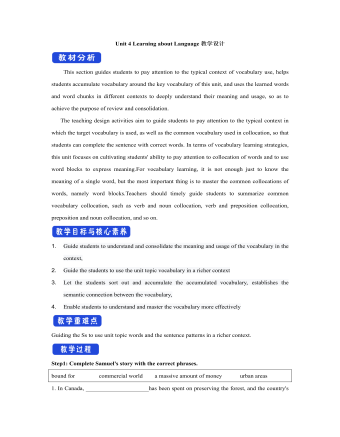
新人教版高中英语选修2Unit 4 Learning about Language教学设计
This section guides students to pay attention to the typical context of vocabulary use, helps students accumulate vocabulary around the key vocabulary of this unit, and uses the learned words and word chunks in different contexts to deeply understand their meaning and usage, so as to achieve the purpose of review and consolidation.The teaching design activities aim to guide students to pay attention to the typical context in which the target vocabulary is used, as well as the common vocabulary used in collocation, so that students can complete the sentence with correct words. In terms of vocabulary learning strategies, this unit focuses on cultivating students' ability to pay attention to collocation of words and to use word blocks to express meaning.For vocabulary learning, it is not enough just to know the meaning of a single word, but the most important thing is to master the common collocations of words, namely word blocks.Teachers should timely guide students to summarize common vocabulary collocation, such as verb and noun collocation, verb and preposition collocation, preposition and noun collocation, and so on.1. Guide students to understand and consolidate the meaning and usage of the vocabulary in the context, 2. Guide the students to use the unit topic vocabulary in a richer context3. Let the students sort out and accumulate the accumulated vocabulary, establishes the semantic connection between the vocabulary,4. Enable students to understand and master the vocabulary more effectivelyGuiding the Ss to use unit topic words and the sentence patterns in a richer context.
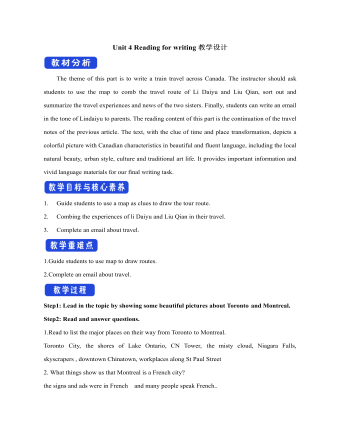
新人教版高中英语选修2Unit 4 Reading for writing教学设计
假定你是英国的Jack,打算来中国旅行,请你给你的中国笔友李华写一封信,要点如下:1.你的旅行计划:北京→泰山→杭州;2.征求建议并询问他是否愿意充当你的导游。注意:1.词数80左右(开头和结尾已给出,不计入总词数);2.可以适当增加细节,以使行文连贯。参考词汇:故宫 the Forbidden City;泰山 Mount TaiDear Li Hua,I'm glad to tell you that 'm going to visit China.First,I am planning to visit Beijing,the capitalof China,where I am looking forward to enjoying the Great Wall,the Forbidden City and somebeautiful parks.Then I intend to go to visit Mount Tai in Shandong Province.I've heard that it is one ofthe most famous mountains in China and I can't wait to enjoy the amazing sunrise there.After that,I amalso going to Hangzhou.It is said that it is a beautiful modern city with breathtaking natural sights,among which the West Lake is a well- known tourist attraction.What do you think of my travel plan? Will you act as my guide? Hope to hear from you soon.
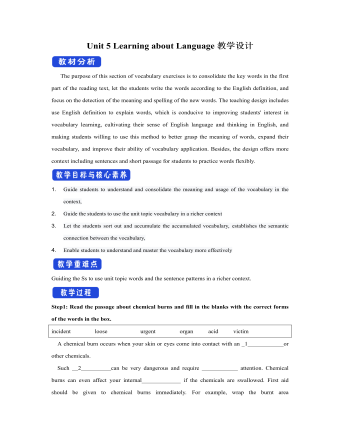
新人教版高中英语选修2Unit 5 Learning about Language教学设计
The purpose of this section of vocabulary exercises is to consolidate the key words in the first part of the reading text, let the students write the words according to the English definition, and focus on the detection of the meaning and spelling of the new words. The teaching design includes use English definition to explain words, which is conducive to improving students' interest in vocabulary learning, cultivating their sense of English language and thinking in English, and making students willing to use this method to better grasp the meaning of words, expand their vocabulary, and improve their ability of vocabulary application. Besides, the design offers more context including sentences and short passage for students to practice words flexibly.1. Guide students to understand and consolidate the meaning and usage of the vocabulary in the context, 2. Guide the students to use the unit topic vocabulary in a richer context3. Let the students sort out and accumulate the accumulated vocabulary, establishes the semantic connection between the vocabulary,4. Enable students to understand and master the vocabulary more effectivelyGuiding the Ss to use unit topic words and the sentence patterns in a richer context.Step1: Read the passage about chemical burns and fill in the blanks with the correct forms of the words in the box.
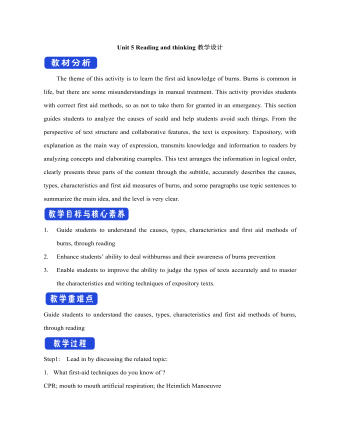
新人教版高中英语选修2Unit 5 Reading and thinking教学设计
The theme of this activity is to learn the first aid knowledge of burns. Burns is common in life, but there are some misunderstandings in manual treatment. This activity provides students with correct first aid methods, so as not to take them for granted in an emergency. This section guides students to analyze the causes of scald and help students avoid such things. From the perspective of text structure and collaborative features, the text is expository. Expository, with explanation as the main way of expression, transmits knowledge and information to readers by analyzing concepts and elaborating examples. This text arranges the information in logical order, clearly presents three parts of the content through the subtitle, accurately describes the causes, types, characteristics and first aid measures of burns, and some paragraphs use topic sentences to summarize the main idea, and the level is very clear.1. Guide students to understand the causes, types, characteristics and first aid methods of burns, through reading2. Enhance students’ ability to deal withburnss and their awareness of burns prevention3. Enable students to improve the ability to judge the types of texts accurately and to master the characteristics and writing techniques of expository texts.Guide students to understand the causes, types, characteristics and first aid methods of burns, through readingStep1: Lead in by discussing the related topic:1. What first-aid techniques do you know of ?CPR; mouth to mouth artificial respiration; the Heimlich Manoeuvre
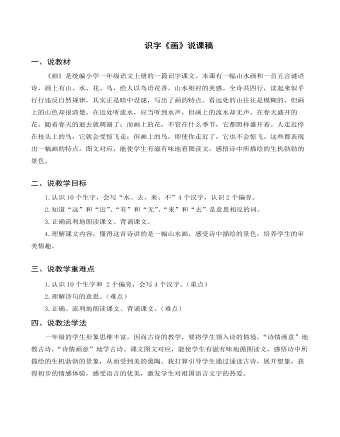
部编人教版一年级上册识字《画》说课稿
二、说教学目标1.认识10个生字,会写“水、去、来、不”4个汉字,认识2个偏旁。2.知道“远”和“近”、“有”和“无”、“来”和“去”是意思相反的词。3.正确流利地朗读课文、背诵课文。4.理解课文内容,懂得这首诗讲的是一幅山水画,感受诗中描绘的景色,培养学生的审美情趣。三、说教学重难点1.认识10个生字和 2个偏旁,会写4个汉字。(重点)2.理解诗句的意思。(难点)3.正确、流利地朗读课文、背诵课文。(难点)四、说教法学法一年级的学生形象思维丰富,因而古诗的教学,要将学生领入诗的情境,“诗情画意”地教古诗,“诗情画意”地学古诗。课文图文对应,能使学生有滋有味地循图读文,感悟诗中所描绘的生机勃勃的景象,从而受到美的熏陶。我打算引导学生通过诵读古诗,展开想象,获得初步的情感体验,感受语言的优美,激发学生对祖国语言文字的热爱。

部编人教版一年级上册识字《金木水火土》说课稿
二、说学情培养学生主动识字的愿望和独立识字的能力,是课程标准着力强调的基本理念。因此,本节课教师以自主交流、小组互为主体,努力将学生的识字愿望与课程标准理念相结合,引导学生“学习独立识字”,获得识字过程的丰富体验。三、说教学目标1.通过猜字谜、熟字比较等方法,能正确认读“一、二、三、四、五、上、下”等7个生字;通过教师指导,学生相互评价等能正确书写笔画“一 丨”和“一、二、三、上”;2.通过教师领读等多种方式能正确流利朗读课文,感受数字儿歌的特点。3.通过诵读儿歌的形式,引导学生掌握正确的书写和握笔姿势。四、说教学重、难点1.能正确流利朗读课文,感受数字儿歌的特点。(重点)2.通过教师指导,学生相互评价等能正确书写笔画“一 丨”和“一、二、三、上”。(难点)
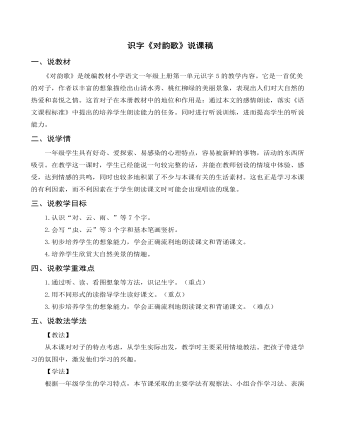
部编人教版一年级上册识字《对韵歌》说课稿
(一)游戏导入,激趣促学1.游戏规则:教师说一个词语,学生边拍手边说出它的反义词。如:老师说“天”,学生说“地”。?2.教师在几组反义词中间分别加上“对”字,让学生再次朗读。3.导入读题。同学们玩对对子游戏特别聪明,?今天,我们一起来学习和自然景物有关的《对韵歌》。来,孩子们,请读课题——对韵歌。?(简洁为其特点,不要啰嗦。)(二)初读课文,读通读顺过渡:音乐课上,老师听孩子们唱歌非常好听,其实,韵文读好了,也像你们唱歌一样好听。不信,你听---教师范读。? 1.自由练读。请孩子们自己学着读一遍吧!学生自由读课文。??2.检查读文。谁来试着读给大家听指名读后,同桌两人听读。?3.师生合作读两遍。(老师当大喇叭,孩子们当小喇叭。)?(每一个内容过渡到下一个内容,必须循序渐进和符合学生的认知规律。体现新课标的精神。)
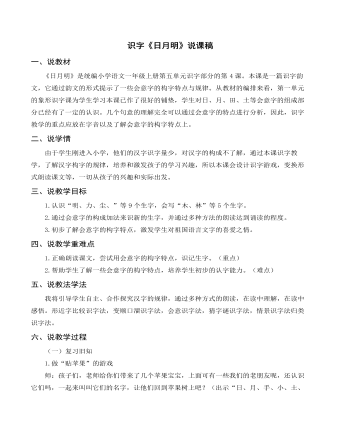
部编人教版一年级上册识字《日月明》说课稿
(三)变化形式,读熟课文,初识生字1.请大家打开书72页,借助拼音自读课文。2.指名读,纠正不正确的读音。3.这篇课文共有8横排,这次我们男女生PK,女生读前4排,男生读后4排,注意读准字音。4.生字宝宝来到了屏幕上,你能读吗?借助拼音自己读。哪个小老师来教一教,一人教两排。5.孩子们学得真认真,那我们给这些字宝宝排排队,睁大你的火眼金睛,你能看出他们的规律吗?正音归类:前鼻韵母(尘、林、森)、后鼻韵母(明、从、中)、平舌音(从、森)、翘舌音(尘、众)。6.你们真能干。不过,老师还要看大家是否真的掌握,一起来开火车。7.加大难度,去掉拼音读。看大屏幕!一组读一排。8.的确很专心。这次我们合作读,老师隐去了第三个字,首先男生读,第二遍女生读隐去一二个字的内容。
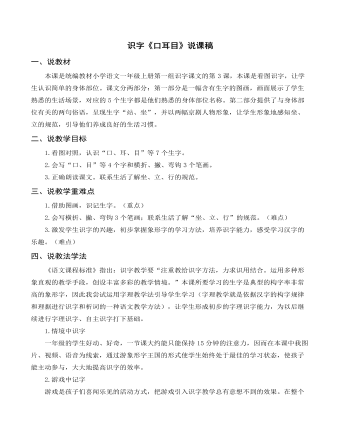
部编人教版一年级上册识字《口耳目》说课稿
一、说教材本课是统编教材小学语文一年级上册第一组识字课文的第3课,本课是看图识字,让学生认识简单的身体部位。课文分两部分:第一部分是一幅含有生字的图画,画面展示了学生熟悉的生活场景,对应的5个生字都是他们熟悉的身体部位名称。第二部分提供了与身体部位有关的两句俗语,呈现生字“站、坐”,并以两幅京剧人物形象,让学生形象地感知坐、立的规范,引导他们养成良好的生活习惯。 二、说教学目标1.看图对照,认识“口、耳、目”等7个生字。2.会写“口、目”等4个字和横折、撇、弯钩3个笔画。3.正确朗读课文。联系生活了解坐、立、行的规范。三、说教学重难点1.借助图画,识记生字。(重点)2.会写横折、撇、弯钩3个笔画;联系生活了解“坐、立、行”的规范。(难点)3.激发学生识字的兴趣,初步掌握象形字的学习方法,培养识字能力,感受学习汉字的乐趣。(难点)
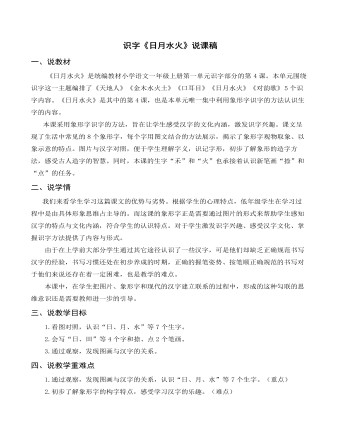
部编人教版一年级上册识字《日月水火》说课稿
1.兴趣教学法。低年级学生注意力持续时间短,容易分散,而兴趣是解决这个问题的关键。在教学中,我通过运用恰当的肢体语言和生动、活泼的儿童化语言;形式多样的识字游戏;从始至终让孩子们的注意力都放在课堂上,达到识字和组词的目的,提高识字能力。??? 2.情境教学法。这是从激发学生的学习兴趣和体现学科整合这两方面去考虑的。在教学中我通过图画,生动形象的板书,卡片游戏,小组比赛的形式重现知识情境调动学生的多种感官直接参与学习,在创设的情境中促使学生更好地识字。3.赏识教学法。没有赏识,就没有教育。在学生练读字,词、参与游戏、展示学习成果、教师相机指导等环节,我活用赏识语言;当众表扬赏识;用欣赏、赞许的目光赏识;用友善的动作赏识;用模糊赏识等赏识方式激发学生学习的兴奋点,给学生注入了巨大的学习动力。
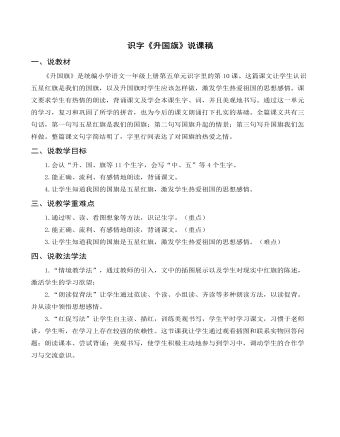
部编人教版一年级上册识字《升国旗》说课稿
一、说教材《升国旗》是统编小学语文一年级上册第五单元识字里的第10课。这篇课文让学生认识五星红旗是我们的国旗,以及升国旗时学生应该怎样做,激发学生热爱祖国的思想感情。课文要求学生有热情的朗读,背诵课文及学会本课生字、词,并且美观地书写。通过这一单元的学习,复习和巩固了所学的拼音,也为今后的课文朗诵打下扎实的基础。全篇课文共有三句话,第一句写五星红旗是我们的国旗;第二句写国旗升起的情景;第三句写升国旗我们怎样做。整篇课文句字简结明了,字里行间表达了对国旗的热爱之情。二、说教学目标1.会认“升、国、旗等11个生字,会写“中、五”等4个生字。2.能正确、流利、有感情地朗读,背诵课文。4.让学生知道我国的国旗是五星红旗,激发学生热爱祖国的思想感情。
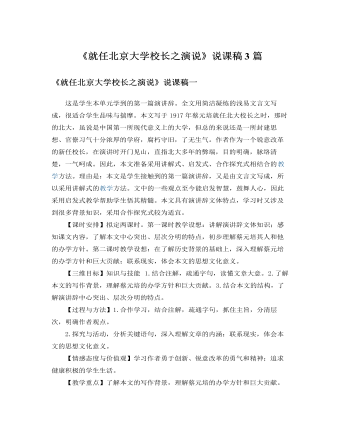
人教版高中语文必修2《就任北京大学校长之演说》说课稿3篇
(三)教学重、难点1、教学重点:结合课文,了解演讲辞针对性强、条理清楚、通俗易懂、适当的感情色彩等特点。2、教学难点:深入理解文章内涵,联系现实,体会本文的现实意义二、说学情高中学生在初中阶段已经接触过演讲辞了,对演讲词的特点已经有了一些基本的知识,因此本轮的教学应该让他们在此基础上有所提高。本文是学生在高中阶段第一次接触演讲辞,有必要让他们了解演讲辞的特点及课文如何体现这些特点的。随着年龄的增长,生活阅历的增加,高中学生正逐渐形成自己对世界、对人生的看法,蔡元培先生的这篇文章能很好地激发他们对当前的高中学习和未来的大学生活进行思考。此外,学生对北大的历史及蔡元培先生作这番演讲的时代背景了解不深,应作出补充说明。
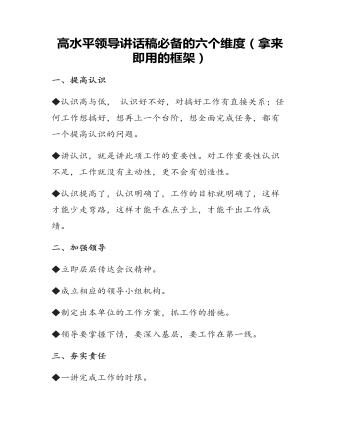
高水平领导讲话稿必备的六个维度(拿来即用的框架)
三、夯实责任◆一讲完成工作的时限。◆二讲工作任务要层层分解,落实责任。◆三讲工作中要齐心协力,上下联动,相互配合。◆四讲工作要分步推进,稳步实施。◆五讲要注意解决工作中出现的问题,要创造性地开展工作。

